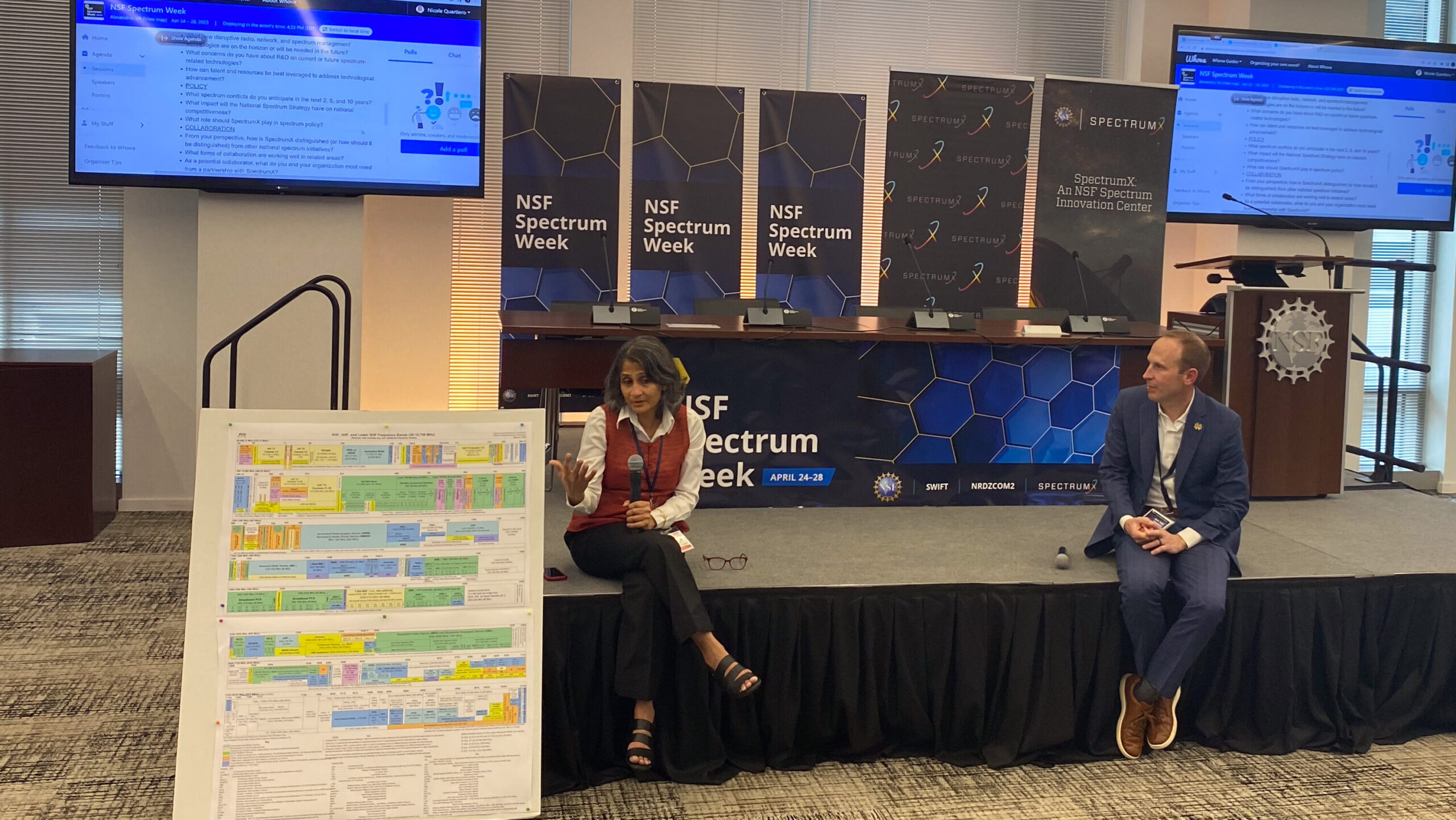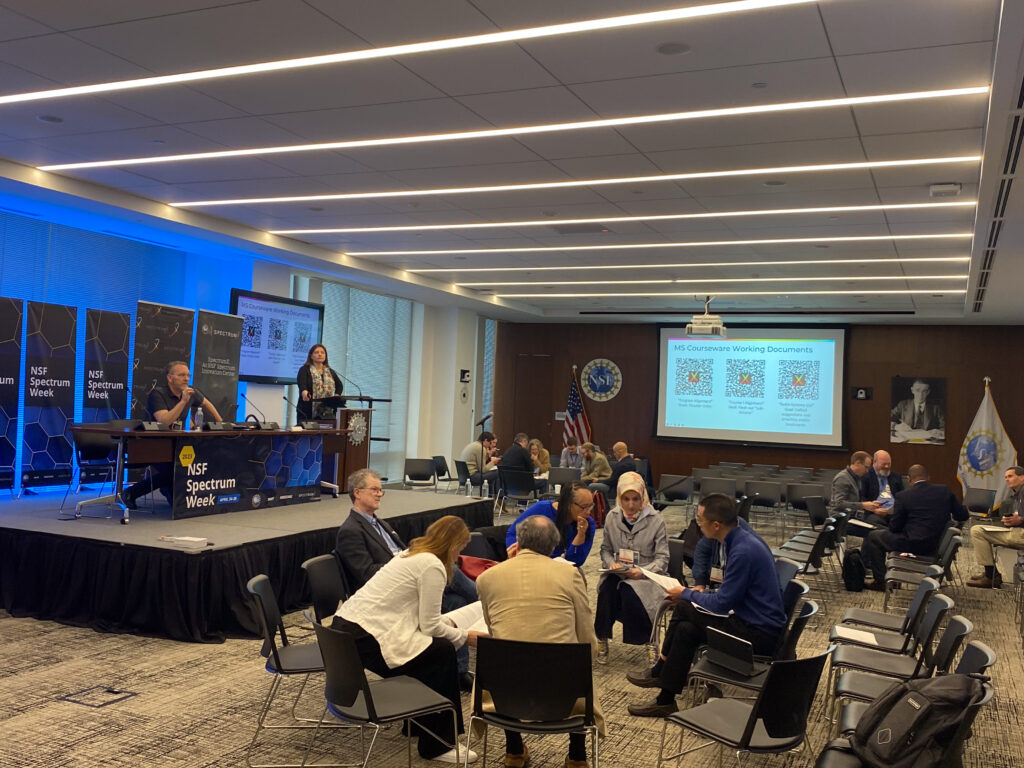By Christina Clark
Throughout the National Science Foundation (NSF) Spectrum Week event at the end of April, three centers funded by NSF Spectrum Innovation Initiative grants came together to hold meetings and events in the collaborative environment. The opportunity to organize the event was driven by SpectrumX, an NSF Spectrum Innovation Center and the world’s largest academic hub for spectrum innovation. The multi-institutional and multidisciplinary center used the opportunity to meet with other SII funded centers, join discussions and sessions, and include students in these forward-thinking conversations.
Nick Laneman, SpectrumX Director and Professor of Electrical Engineering at the University of Notre Dame, kicked off the SpectrumX Center Meeting with a center overview and his thoughts on the value of NSF Spectrum Week
“Through our engagement with this important event, we can figure out what we need to do integratively across our team and we can learn how to adjust our programs. The organization of Spectrum Week was very intentional. We look forward to how it can accelerate the processes of exchanging ideas across the spectrum community,” said Laneman.
SpectrumX Center Meeting
As the SpectrumX Center Meeting began on Thursday afternoon, an interactive discussion was hosted by Josh Tullis, SpectrumX Managing and Collaboration Director, with fellow SpectrumX leadership members to foster discussion on technology, policy, and collaboration.
Tullis took the lead on the collaboration discussion, focusing on what forms of collaboration members and potential members see as successful, and where they suggest support.

Monisha Ghosh, SpectrumX Policy Outreach Director, sits on the NSF Spectrum Week stage to discuss spectrum conflicts and policy during the SpectrumX Center Meeting. Josh Tullis, SpectrumX Managing Director, sits on the stage listening to her speak.
For technology, Tullis paired with Michael Honig, SpectrumX Research Director and Project Team Lead and Professor at Northwestern University, to discuss disruptive technologies in radio, network, and spectrum, as well as concerns and resources.
Monisha Ghosh, SpectrumX Policy Outreach Director, joined Tullis to discuss anticipated spectrum conflicts, the impact of the National Spectrum Strategy, and how SpectrumX can influence and educate in the policy realm.
“During Spectrum Week, we had the unique opportunity to connect with members of the Federal Communications Commission (FCC), National Telecommunications and Information Administration (NTIA), and other stakeholders to ask questions in real time about current and future spectrum priorities for commercial, scientific and federal uses of spectrum,” Ghosh said. “This is an important function that SpectrumX fulfills: a neutral platform for discussing potential spectrum conflicts and evaluating solutions.”
Center Research Overview

Michael Honig, SpectrumX Research Director, Project Team Lead, and Professor at Northwestern University, moderates a discussion on the center’s research with Josh Tullis, SpectrumX Managing and Collaboration Director.
On Friday, SpectrumX lead researchers gave 10-minute lightning talks as updates. Honig gave an overview of how the center approaches research prior to each leader in their area of focus taking the stage.
“To address challenges and trends in spectrum management, there has to be an interplay between technical analysis and the regulatory process. The foundation for this interplay is data,” said Honig. “We want to collect data to support technical analysis, which could be in the form of utilization, traffic statistics, and propagation characteristics, in order to determine whether coexistence between two applications is feasible. On the regulatory side we want to collect data that is useful for economic analysis, such as social welfare metrics, like prices, revenues, and market structures, in order to inform regulators of what makes sense in terms of access rights.”
Updates were given after by Project Team (PT)-Rights, PT-Active and Enforcement, PT-Data, PT-Passive, and PT-Sensing group leadership before a poster session featuring student and center research.
Student Engagement


SpectrumX affiliated students, faculty, and researchers came together to discuss current and future projects.
Following the lightning talks, students studying with faculty and engaging in programs supported by SpectrumX hosted a poster session to discuss their work with attendees.
Nearly 40 students, ranging from undergraduate to doctoral candidates, attended Spectrum Week. Four SpectrumX affiliated Minority Serving Institutions (MSIs) had students in attendance presenting their research, including Florida Agricultural and Mechanical University, Florida International University, University of Puerto Rico at Mayagüez, and University of the Virgin Islands. Students were able to present their own work, as well as that of the center’s recently launched broadband mapping project.

Students ranging from undergraduates to PhD candidates are pictured together at NSF Spectrum Week.
Education and Workforce Development Sessions
During the last afternoon of Spectrum Week, SpectrumX hosted policy and education and workforce development discussions where researchers, educators, and stakeholders collaborated on solving future challenges. Anja Fourie, SpectrumX Education and Workforce Development Director and Project Director of RADIAL at the National Radio Astronomy Observatory, led the facilitation of the final session on the collaborative development of the center’s aim for an accessible, master’s-level course.
“As a NSF-supported Center, SpectrumX aligns its vision for broader impacts with that of the NSF, and so aims to contribute to a diverse and competitive STEM workforce,” said Fourie. “This workforce will need to have skills that are transferable because the workplace and technologies are changing so quickly. We need to have young people that can move easily between different workplaces, different environments. We all know how important that was during COVID-19. We need to pull together a diverse network of partners, who look at these issues in different ways.”
There were five working groups that attendees could self-assign to, including Passive Scientific Sensing, Active Scientific Sensing, Terrestrial Telecommunications, Satellite Constellations, Spectrum Management/Sharing Mechanisms to discuss how the center can address each topic from an educational standpoint in the future.

Participants divided up into working groups during the Education and Workforce Development sessions at the NSF Spectrum Week hosted-SpectrumX Center meeting.
Unique Opportunities for Participation
The week also featured a special opportunity to attend a private screening of “When Wire Was King,” directed and executive produced by Jennifer Manner, Senior Vice President of Regulatory Affairs at EchoStar Corporation. According to the film’s description, “‘When Wire Was King: The Transformation of Telecommunications’ is a feature-length documentary that puts the telecommunications revolution into historical context. Commerce, technology, entertainment, travel, health, and all societal interaction are now dependent on secure and reliable telecommunications that, if the plug were pulled, our nation and world would likely collapse.” The evening was organized by SpectrumX, and Manner was in attendance to introduce the movie and hold a discussion after the screening. The movie was recently accepted by American Public Television (APT) for Public Broadcasting Service (PBS) syndication.


Left: An image during the lively discussion after the screening of “When Wire Was King” during NSF Spectrum Week. Right: Image provided by Jennifer Manner from the production of “When Wire Was King.”
The NSF Spectrum Week event was the first of its kind for the spectrum community, with SpectrumX organizing the effort in cooperation with NSF. More information on the next annual Spectrum Week will be announced on spectrumx.org.
Learn more about NSF Spectrum Week here: NSF Spectrum Week
Learn more about SpectrumX here: SpectrumX
About SpectrumX
SpectrumX is funded by the National Science Foundation (NSF) as part of its Spectrum Innovation Initiative, under grant number AST 21-32700. SpectrumX is the world’s largest academic hub where all radio spectrum stakeholders can innovate, collaborate, and contribute to maximizing social welfare of this precious resource.
To learn more about SpectrumX, please visit spectrumx.org.
Contact:
Christina Clark, Research Communications Specialist
SpectrumX / Notre Dame Research / University of Notre Dame
cclark26@nd.edu / 574.631.2665
spectrumx.org

